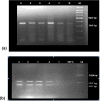Risk Mapping and Situational Analysis of Cutaneous Leishmaniasis in an Endemic Area of Central Iran: A GIS-Based Survey
- PMID: 27574805
- PMCID: PMC5004885
- DOI: 10.1371/journal.pone.0161317
Risk Mapping and Situational Analysis of Cutaneous Leishmaniasis in an Endemic Area of Central Iran: A GIS-Based Survey
Abstract
Introduction: Cutaneous leishmaniasis (CL) is among the top 10 infectious disease priorities in the world, and the leading cause of morbidity in Iran. The present study was conducted to assess the risk of CL, and to determine some epidemiological features of the disease in endemic areas of Qom Province in Central Iran during 2009 to 2013.
Methods: Data regarding human cases of the disease were obtained from the Qom Province Health Center, prepared and stored in a spatial database created in ArcGIS10.3. A total of 9 out of 212 Leishmania spp. positive slides taken in 2013 from patients residing in Qom city were examined using molecular methods and the species of Leishmania was identified by PCR-RFLP. Those 9 patients had no history of travel outside the city. Spatial analysis and clustering methods were applied to find major hot spots and susceptible areas for the establishment of novel foci of the disease. Transmission patterns were examined for spatial autocorrelation using the Moran's I statistical application, and for the clustering of high or low values using the Getis-Ord Gi* statistics.
Results: During the period of study, a total of 1767 CL cases were passively reported in the area, out of which were 65% males and 35% females. The highest and lowest numbers of cases were reported in 2010 and 2013, respectively. Importantly, 979 cases were reported from urban areas, while the remainder came from rural areas. Leishmania major was detected as the causative agent of CL in the city of Qom. Remarkably, most patients recorded in Qom city were associated with a history of travel to the endemic areas of CL within the province, or to other endemic areas of the disease in Iran. Spatial distribution of CL cases revealed northeastern and southwestern quarters of the city were the major hot spots of the disease (P<0.05). Hot spot and CL transmission risk analysis across the province indicated that more than 40 villages were located in high and very high risk areas of CL transmission.
Conclusions: Due to the existence of hot spots (P<0.05) of CL in successive years in some quarters of Qom city, along with detection of L. major from the patients without a history of travel, there may be potential of local transmission of the disease within the city. Therefore, it is necessary to conduct a comprehensive study concerning the hot spots of CL in Qom city for curtailing the incidence of the disease in the city. The methodology and the results of this study is essential in serving as a yardstick for subsequent similar studies that will be carried out in other endemic areas of CL in Iran and providing an adequate tool for the establishment of a national database of cutaneous leishmaniasis.
Conflict of interest statement
The authors have declared that no competing interests exist.
Figures








Similar articles
-
A newly emerged cutaneous leishmaniasis focus in central Iran.Int J Infect Dis. 2013 Dec;17(12):e1198-206. doi: 10.1016/j.ijid.2013.07.003. Epub 2013 Sep 6. Int J Infect Dis. 2013. PMID: 24011629
-
A new focus of zoonotic cutaneous leishmaniasis in Shiraz, Iran.Trans R Soc Trop Med Hyg. 2009 Jul;103(7):727-30. doi: 10.1016/j.trstmh.2008.12.013. Epub 2009 Feb 14. Trans R Soc Trop Med Hyg. 2009. PMID: 19223055
-
An overview of a diagnostic and epidemiologic reappraisal of cutaneous leishmaniasis in Iran.Braz J Infect Dis. 2011 Jan-Feb;15(1):17-21. Braz J Infect Dis. 2011. PMID: 21412584
-
Changes in the Epidemiology of Cutaneous Leishmaniasis in Northeastern Iran.Turkiye Parazitol Derg. 2020 Mar 20;44(1):52-57. doi: 10.4274/tpd.galenos.2019.6137. Turkiye Parazitol Derg. 2020. PMID: 32212595 Review.
-
The Geographical Distribution of Cutaneous Leishmaniasis Causative Agents in Iran and Its Neighboring Countries, A Review.Front Public Health. 2020 Feb 18;8:11. doi: 10.3389/fpubh.2020.00011. eCollection 2020. Front Public Health. 2020. PMID: 32133334 Free PMC article. Review.
Cited by
-
Application of BASNEF model in students training regarding cutaneous leishmaniasis prevention behaviors: a school-based quasi experimental study.BMC Infect Dis. 2021 Nov 17;21(1):1164. doi: 10.1186/s12879-021-06874-2. BMC Infect Dis. 2021. PMID: 34789186 Free PMC article.
-
Cutaneous Leishmaniasis during Pregnancy, Preterm Birth, and Neonatal Death: A Case Report.Iran J Parasitol. 2020 Oct-Dec;15(4):608-614. doi: 10.18502/ijpa.v15i4.4875. Iran J Parasitol. 2020. PMID: 33884019 Free PMC article.
-
Arginase activity in pathogenic and non-pathogenic species of Leishmania parasites.PLoS Negl Trop Dis. 2017 Jul 14;11(7):e0005774. doi: 10.1371/journal.pntd.0005774. eCollection 2017 Jul. PLoS Negl Trop Dis. 2017. PMID: 28708893 Free PMC article.
-
Potential Challenges of Controlling Leishmaniasis in Sri Lanka at a Disease Outbreak.Biomed Res Int. 2017;2017:6931497. doi: 10.1155/2017/6931497. Epub 2017 May 28. Biomed Res Int. 2017. PMID: 28630867 Free PMC article. Review.
-
Situational Analysis of Visceral Leishmaniasis in the Most Important Endemic Area of the Disease in Iran.J Arthropod Borne Dis. 2017 Dec 30;11(4):482-496. eCollection 2017 Dec. J Arthropod Borne Dis. 2017. PMID: 29367925 Free PMC article.
References
-
- World Health Organization (2010) Control of the leishmaniasis. Report of a Meeting of the WHO Expert Committee on the Control of Leishmaniases. WHO Technical Report Series. WHO, Geneva.
MeSH terms
Substances
LinkOut - more resources
Full Text Sources
Other Literature Sources
Miscellaneous

